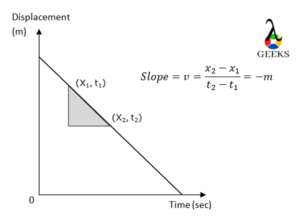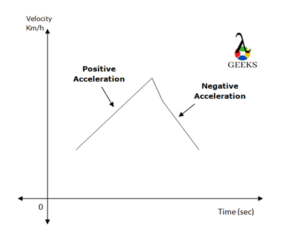In this article, we are going to discuss about the dependency of the negative velocity and negative acceleration on each other with some examples and graphs.
If the object shifts in the direction opposite to its mobility then the velocity of the object is negative. The acceleration of the object is found to be negative if the velocity of an object decreases with time.
What is Negative Velocity?
A negative velocity is a ratio of the displacement of an object in a direction away from its direction of motion.
If the direction of motion of an object is opposite then the displacement then the velocity of the object is negative.
The velocity is given by the equation
v=(Δx/Δt)=(x2-x1)/(t2-t1)—(1)
For velocity to be negative in the above equation (1),
x2>x1
The final displacement of the object should be less than the initial displacement.
What is Negative Acceleration?
An object slowing down with time will show the reduction in the velocity of the object with time and distance.
An object is said to be accelerating if there is a change in the velocity of an object during its motion. The velocity of an object varies and lowers along with the displacement, the speeding down of an object will lower the acceleration of an object.
a=(Δv/Δt)=(v2-v1)/(t2-t1)
For acceleration to be negative in the above equation (2),
v2>v1
For acceleration to be negative, the initial acceleration of an object should be greater than the velocity of the object on further accelerating.
Can you have Negative Velocity and Negative Acceleration?
This is possible in the case of an object slowing down its speed, or falling from a greater height, or moving away from the original direction of motion, reversing its direction.
If the position of an object changes away from its direction of motion and velocity decreases with time, then the object has negative velocity and negative acceleration both.
We can consider a simple example of a comet approaching the Sun from afar nebula by attracting towards the gravitational force of the Sun. But as it approaches near the Sun, it gains potential energy and diverts back from its direction of motion, and accelerates away from the Sun in a parabolic path.
As the comet is far from the Sun, its speed is about 2000 miles per hour, once it reaches near the Sun its speed becomes nearly 100000 miles per hour due to the external gravitational pull of the Sun on the comet. On deflecting from the Sun, its speed is even high and decreases as the distance from the Sun increases.
Hence the velocity of the comet is actually negative while traveling away from the Sun and hence the acceleration is also negative as the velocity decreases with time.
Read more on comets.
Negative Velocity Negative Acceleration Graph
To measure the velocity of the object, we have to plot a graph of displacement of an object at different time duration. The following is a position-time graph of a decelerating object.

The graph shows that the displacement of an object is in a reverse direction and the position of an object from its origin decreases with time. On finding the slope of a position-time graph, you will find the velocity of the graph. In the above graph, the velocity of the object decreases with time and hence the velocity is calculated to be negative.
To find out the acceleration of an object, we plot a graph of velocity v/s time rate of change of velocity. The graph is as follows:

From the graph, we can see that the velocity linearly drops with time. The slope of a graph gives the acceleration of an object. Since the velocity reduces with time, the acceleration is negative.
If the object accelerates at a higher velocity than the previous, then we will have a positive slope of a graph and hence a positive acceleration.
Negative velocity and negative acceleration example
Consider an airplane traveling at a speed of 850 km/h accelerates at a lower altitude to a speed of 580 km/h and then speeds down to the surface of the Earth lowering its speed during its landing. The horizontal velocity of the plane is deduced while the vertical velocity also decreases while the plane is landing on the ground.
Here, in this case, the distance between the airplane and the landing area decreases with time. Initially, the airplane was flying at a height of 10,000 meters above the surface and then follows the lower altitude at a height of 8000 meters in 10 minutes. Then the velocity can be calculated as the change in position with respect to the initial position and the time given by the equation
v=(x2-x1)/(t2-t1)
Here, x1=10000 meters, x2=8000 meters,

Hence, the velocity of the plane while coming down to the lower altitudes is -3.33 m/s. It is seen that as the height of the plane decreases its velocity is calculated and found out to be negative.
The acceleration of a plane is a varied velocity with time, given by the relation
a=(v2-v1)/Δt
The initial velocity of the airplane was 850km/h which was then reduced to 580km/h. Hence, the acceleration of the plane with decreasing velocity is
We have v1=850 km/h, v2=580 km/h, Δt=600 seconds
a=(580-850)/600=-270/600=-0.45m/s2
Since the velocity decreases with time, the acceleration becomes negative.
How Negative Velocity and Negative Acceleration Works?
The velocity is directly related to the change in the displacement whereas the acceleration of the object depends upon the change in its velocity.
The negative velocity reverses the direction of the object as the displacement is in the negative axis of the system while the speed of the object is reduced due to negative acceleration.
The negative velocity pulls back the object in a direction opposite to its motion and the negative acceleration slows down the speed of an accelerating object and hence it decelerates.
The object falling on the ground from a certain height converts the potential energy to the kinetic energy utilized to displace itself from the height to the ground surface. The height of the object from the ground from where its flight was initially started decreases. Compatibility, the velocity of the object is negative as the displacement of an object is in a negative axis.
Suppose we throw an object in a projectile motion, the velocity of the object on reaching the highest height reduces once all the kinetic energy of the object is converted back into the potential energy of the object.
From here the velocity of the object initially increases as the potential energy is converted into kinetic energy and due to the gravitational force acting on the object, and then slightly decreases the velocity while accelerating downward and deducts sharply when it reaches near the surface of the Earth.
As the velocity decreases with time, the difference in the preceding and the initial velocity is negative and hence the acceleration of the object is negative.
When Velocity is Negative and Acceleration is Negative what is happening to the Object?
When the velocity is negative of the object the displacement is in the reverse direction and when acceleration is negative the speed of the object accelerating is reduced.
As the velocity and as well as the acceleration of the object decreases, the kinetic energy of the object is converted into the potential energy of the object. We can even consider that there is some external impact on the object due to which the velocity of the object lowers.
Read more on Negative Velocity Graph: Different Graphs And Their Explanations.
Frequently Asked Questions
Q1. How does the graph of velocity v/s time for the comet approaching the Sun and then deflecting back will look like? Explain the graph for the same regarding velocity and acceleration.
The speed of the comet while approaching the Sun from the far distance is around 2000km/h, and increases as the gravitational pull on the comet increases with decreasing distance
The speed becomes approximately 1L km/h when it is near the Sun. Hence, the change in velocity of the comet is positive and therefore the acceleration of the comet is also positive as shown in the graph below.

It receives the energy from the sun and sweeps back against the gravitational pull of the Sun gradually decreasing its velocity as it elapses the distance away from the Sun. Initially, there will be a major fall in the velocity as the comet will lose its extra energy received from the radiation of the Sun quickly.
Since the velocity of the comet decreases the acceleration of the comet is negative and the same is shown in the graph where the velocity is sloping down with time.
Q2. Consider an object slowing down, base on the displacement of an object away from its original position with time the velocity was calculated and plotted for the same time interval. The graph is shown below. Based on the following graph calculate the acceleration of the object when time is equal to 5 seconds.

Solution: From the above graph, the velocity of the object at time t=5seconds, the velocity of the object was v=-20 m/s.
The velocity is the product of the acceleration of the object during that time.
Hence, the acceleration of the object is
Therefore, the acceleration rate of an object at time t=5 seconds was -4m/s2.
Is negative acceleration the same as the deceleration of the object?
The acceleration of the object is negative if the velocity of the object is lowering with time.
If the velocity of the object along with the distance decreases, then the object is said to be decelerated with time. The decelerating object accompanies with negative acceleration.
Why does the velocity of a falling object from the height be negative?
If the object moves in a reverse direction then the difference between the final and initial displacement is negative.
Since the displacement of a falling object is in a reverse direction, its velocity and hence the acceleration will be negative.
Is it possible to measure the distance covered by an object from its velocity-time graph?
Yes, the displacement of an object can be found from the velocity-time graph.
Since velocity is defined as a distance elapsed by the object in a given time, then distance will be equal to the velocity of the object during that time and the time duration at which the velocity was noted.
Also Read:
- How to find torque from angular velocity
- Is angular velocity a vector
- How to determine velocity in plasma physics
- Zero velocity graph
- How to measure velocity in x ray diffraction
- How to find velocity with acceleration and distance
- How to compute velocity in stellar dynamics
- How to derive velocity in thermodynamics
- Find coefficient of friction given velocity and distance
- How to find velocity in quantum chromodynamics
Hi, I’m Akshita Mapari. I have done M.Sc. in Physics. I have worked on projects like Numerical modeling of winds and waves during cyclone, Physics of toys and mechanized thrill machines in amusement park based on Classical Mechanics. I have pursued a course on Arduino and have accomplished some mini projects on Arduino UNO. I always like to explore new zones in the field of science. I personally believe that learning is more enthusiastic when learnt with creativity. Apart from this, I like to read, travel, strumming on guitar, identifying rocks and strata, photography and playing chess.